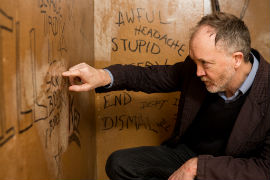Sex Pistols and archaeology did make the news – in November 2011. That was the year when Paul Graves-Brown and John Schofield published their article ‘The filth and the fury: 6 Denmark Street (London) and the Sex Pistols’ in the journal Antiquity. This article made newspapers to write all kinds of articles on their pages. First the mood was stunned but then some papers like The Guardian got the idea and did not find it infuriating. To be honest, at the beginning they were puzzled and horrified how the archaeologists could compare the drawings of John Lydon, Johnny Rotten, to the Paleolithic cave paintings but after Paul Graves-Brown wrote a piece on their pages. However, the Daily Mail could not quite forget the upset the band caused in their hayday and kept their negative tone.
In the whole saga, Historic England came out as a progressive body. The archaeology Paul Graves-Brown and John Schofield had discussed were the drawings on the wall made by John Lydon while the band was living on 6 Denmark Street, the so-called Tin Pan Alley of the music business. The drawings had been found under the wallpaper undamaged and the archaeologists got a change to record them in the nowadays backroom of a guitar shop. They managed to photograph them all in their time there. This archaeology then made one part of the reasons why the building became II* graded listed building – on the 40th anniversary of publishing the God Save the Queen. That I call being progressive. Although one has to point out that the houses in question are unusually lovely examples of the 17th century traders’ houses that have not survived elsewhere.
These events had totally passed me by until John Schofield came to Stockholm and gave a talk to them. So here you have it: old news with a contemporary twist. John Schofield wants to promote so-called ‘punk archaeology’ that similarly to punk allows all to have a say in heritage. 6 Denmark Road he and his co-author have named anti-heritage because it was anti-establishment. If I understood correctly, their intension is more to let normal people to have say what they see as their heritage than clash with the government. This sound quite a lot of the community projects different bodies have been engaged lately. We could now see crowd-sourcing and crowdfunding as punk. But how bottom-to-top is that in the current heritage climate?

Thanks for sharing these ideas about using marble in interior design.
ReplyDeleteIrish landscape photography
Ireland scenic views
Natural beauty of Ireland
Wild Atlantic Way
Cliffs of Moher landscape
Irish countryside vibes
Green landscapes of Ireland
Ireland hiking trails
Best landscape spots in Ireland
Emerald Isle nature
Thanks for sharing these ideas about using marble in interior design.
ReplyDeleteSwiss landscape design
Alpine gardens Switzerland
Scenic views Switzerland
Landscape architecture Zurich
Natural beauty Switzerland
Outdoor living spaces Switzerland
Sustainable landscaping Switzerland
Modern garden design Switzerland
Landscape contractors Switzerland
Mountain views real estate Switzerland